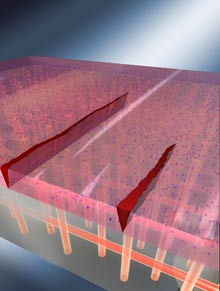 Self-healing plastic Self-healing plastic
Self-healer: Modeled on human skin, a new material that heals itself multiple times is made of two layers. The polymer coating on top contains tiny catalyst pieces scattered throughout. The substrate contains a network of microchannels carrying a liquid healing agent. When the coating cracks, the cracks spread downward and reach the underlying channels, which ooze out healing agent. The agent mixes with the catalyst and forms a polymer, filling in the cracks.
Credit: J. Hanlon, Univ. of Illinois Beckman Institute
Researchers at the University of Illinois at Urbana-Champaign (UIUC) have made a polymer material that can heal itself repeatedly when it cracks. It's a significant advance toward self-healing medical implants and self-repairing materials for use in airplanes and spacecraft. It could also be used for cooling microprocessors and electronic circuits, and it could pave the way toward plastic coatings that regenerate themselves.
The first self-healing material was reported by the UIUC researchers six years ago, and other research groups have created different versions of such materials since then, including polymers that mend themselves repeatedly when subject to heat or pressure. But this is the first time anyone has made a material that can repair itself multiple times without any external intervention, says Nancy Sottos, materials-science and engineering professor at UIUC and one of the researchers who led the work.
"It's essentially like giving life to a plastic," says Chris Bielawski, a chemistry professor at the University of Texas at Austin. The ultimate goal would be to create materials that mend themselves, he says, and "this is an amazing proof of concept."
Sottos and her colleagues have designed the new material, reported in this week's Nature Materials, to mimic human skin. If the skin's outer protective layer is cut, the inner layer, which is infused with a dense network of tiny blood vessels, rushes nutrients to the cut to help with healing. The self-healing material consists of an epoxy polymer layer deposited on a substrate that contains a three-dimensional network of microchannels. The epoxy coating contains tiny catalyst particles, while the channels in the substrate are filled with a liquid healing agent.
To test the material, the researchers bend it and crack the polymer coating. The crack spreads down through the coating and reaches the underlying microchannel. This prompts the healing agent to "whip through the channels and into the crack," Sottos says. There, it comes into contact with the catalyst and, in about 10 hours, becomes a polymer and fills in the crack. The system does not need any external pressure to push the healing agent into the crack. Instead, the liquid moves through the narrow channels just as water moves up a straw.
The researchers are able to crack and reheal the surface as many as seven times before the catalyst wears out and stops working. The next generation of the self-healing material should be able to heal itself many more times, according to the researchers. Sottos and her colleagues are designing it so that it will have a two-part system that injects both a healing agent and a catalyst into the crack.
The researchers could also increase the rehealing capacity of the material by hooking up the microchannel network to a little reservoir, Sottos says. If the material runs out of healing agent or catalyst, the reservoir could pump in more.
The material's microchannel design could be a solution to the increasing problem of heat buildup in microelectronics chips. Typically, microelectronic circuit chips sit on substrates that are designed to conduct heat away from the circuit. These heat regulators have their limits. Instead, Sottos says, "you could put a cooling fluid through a [microchannel] network like a little mini-heat exchanger."
Sottos says that researchers could use the same design with other resin and catalyst combinations that can form different polymers. This opens the door for many other applications. While practical self-healing materials might be years away, it's easy to imagine their applications in prosthetics and medical implants made from biocompatible self-healing materials. The cost of the materials might keep them limited, at least initially, to certain high-value, high-performance applications such as use in air- and spacecraft, says Ian Bond, aerospace engineering professor at the University of Bristol, in the United Kingdom.
In the future, different chemistries could lead to cheaper self-healing materials, according to Bielawski. "You could use cheap epoxies ... that you can buy at Home Depot ... as a healing agent," he says. |
